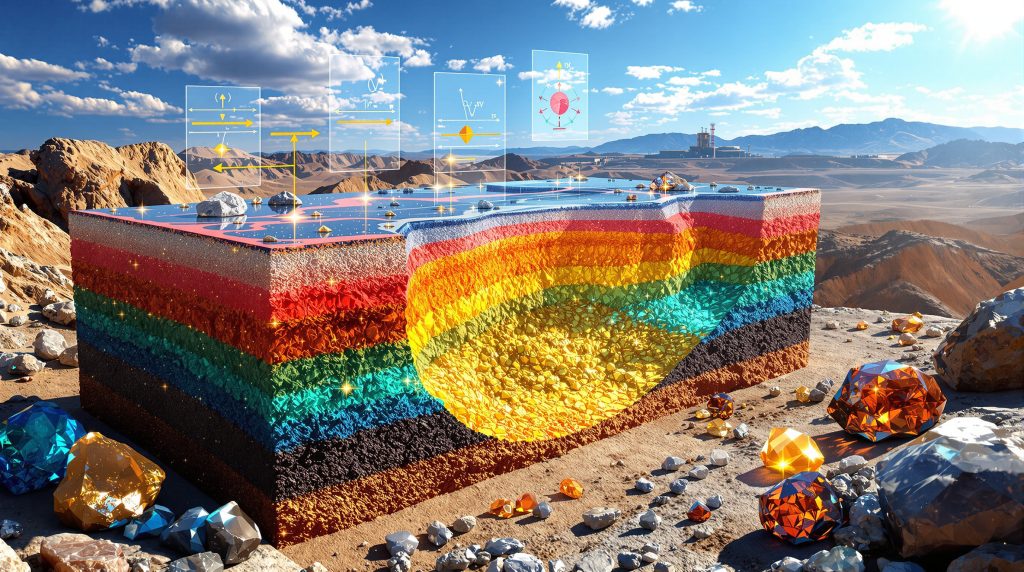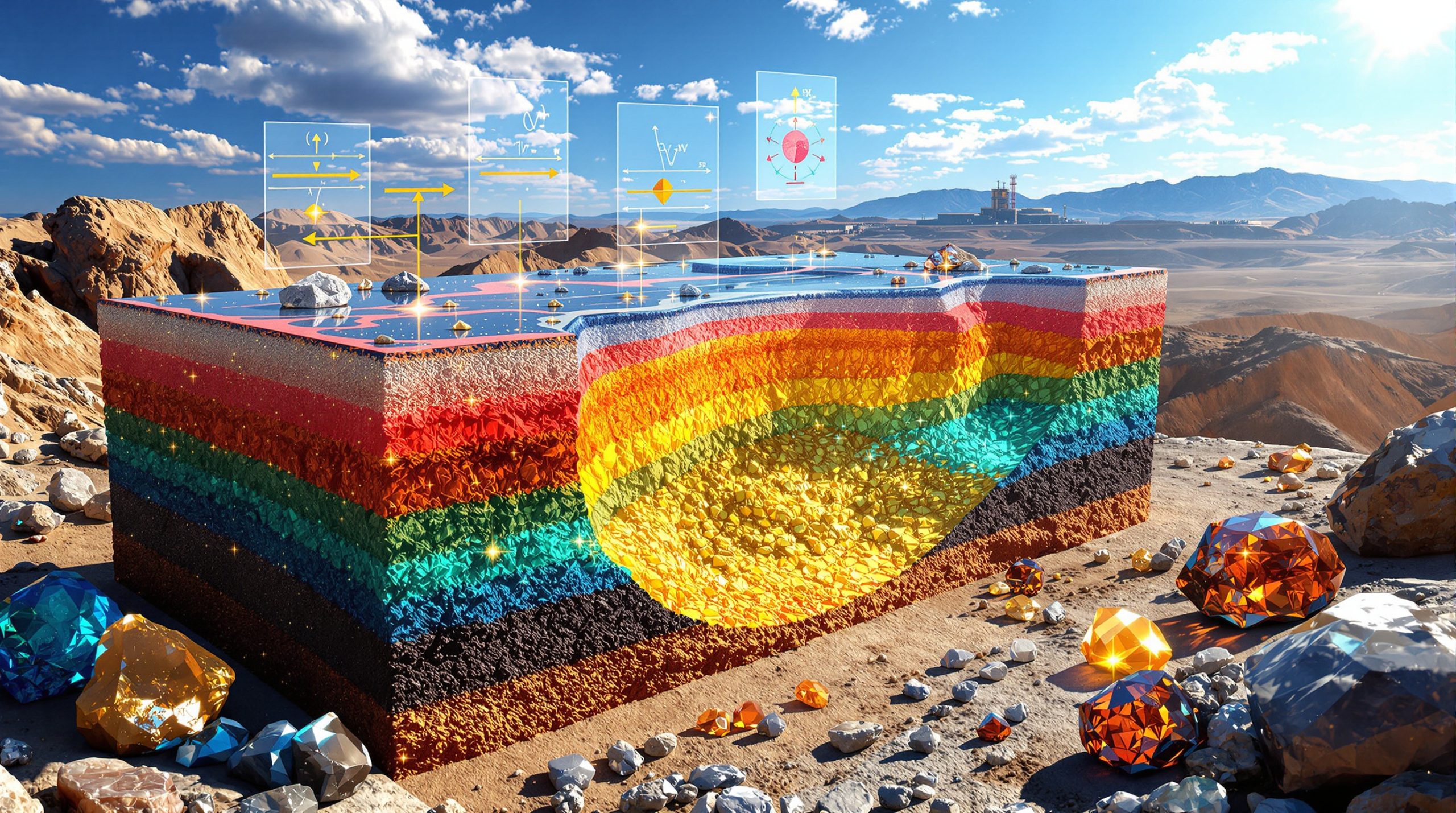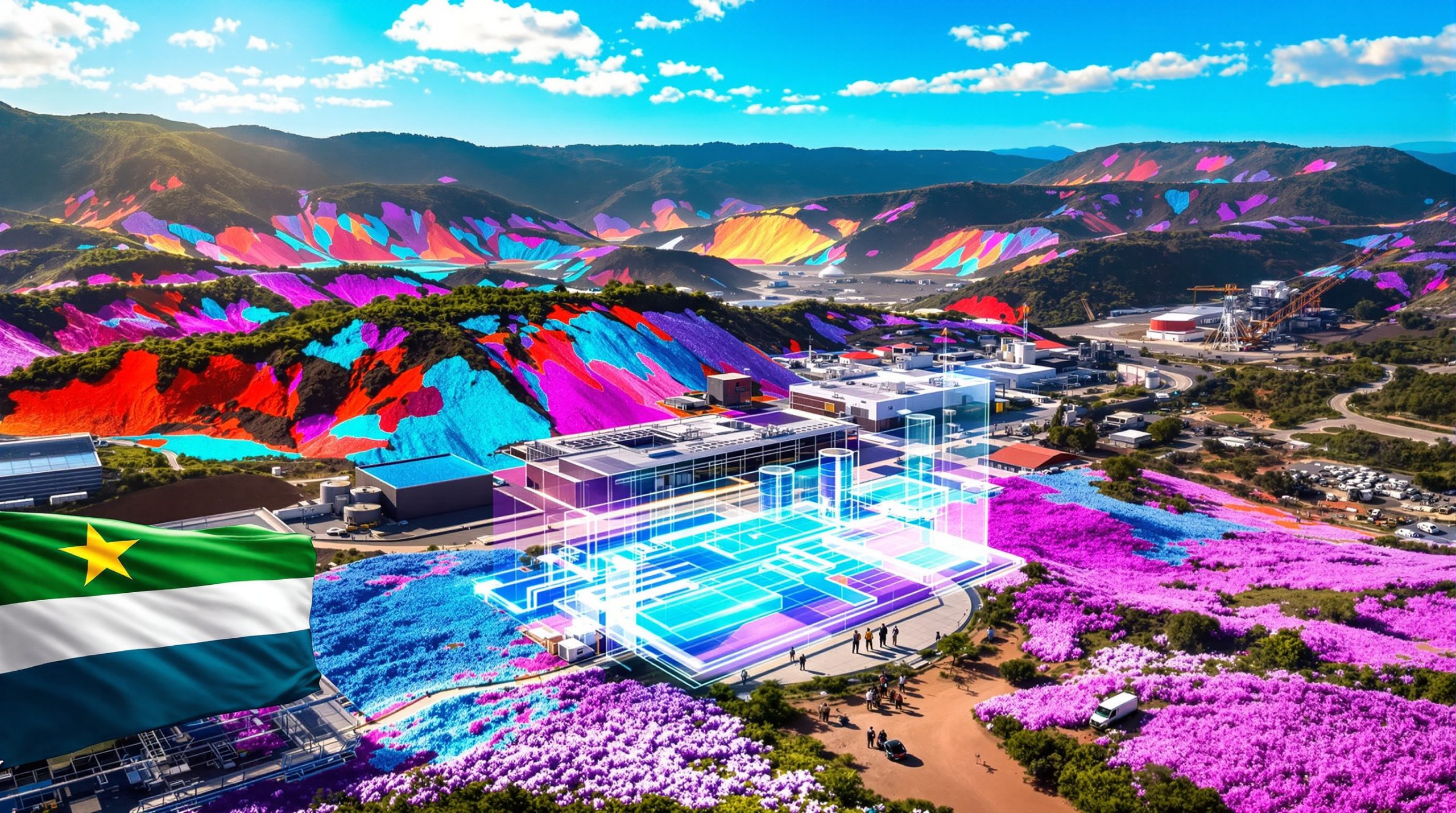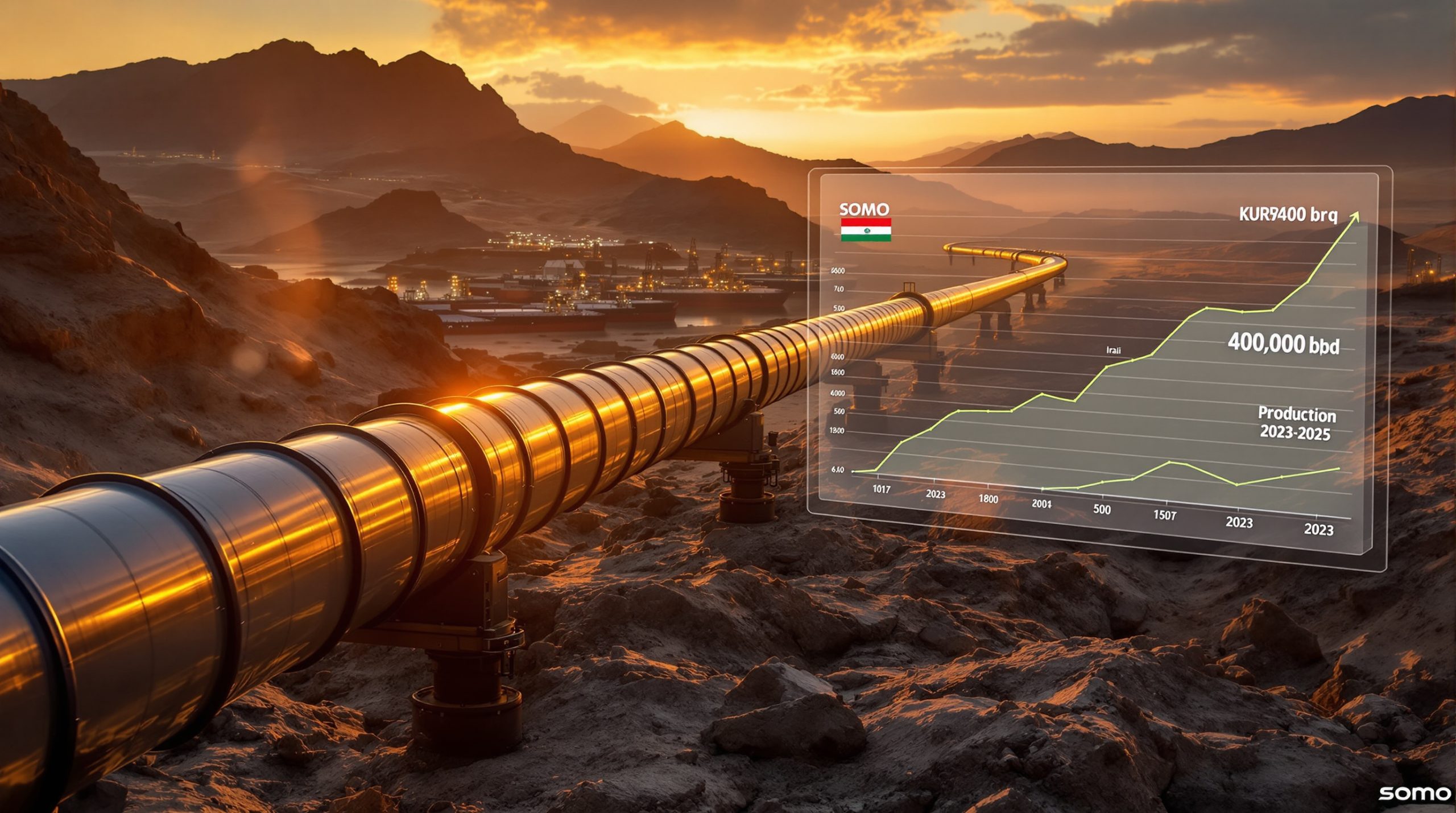What Are Porphyry Copper Deposits and Why Are They Important?
Porphyry copper deposits stand as geological titans in the world of mineral resources, representing some of Earth's most valuable concentrations of metals. These massive systems serve as the primary source of global copper production and frequently contain significant quantities of molybdenum, gold, and other economically important metals. Their distinctive formation processes involve complex interactions between magmatic and hydrothermal activities, creating enormous volumes of mineralized rock.
These geological formations have achieved critical economic importance because they supply approximately 60-70% of the world's copper needs. Their immense scale—often containing billions of tons of mineralized rock—allows for economically viable extraction despite relatively low metal grades, typically ranging from 0.3% to 1.0% copper. The frequent presence of valuable by-products like gold, silver, and molybdenum further enhances their economic significance.
Key Features That Define Porphyry Copper Systems
Porphyry deposits exhibit several characteristic features that distinguish them from other mineral deposits. They form in association with porphyritic intrusive rocks—igneous formations containing large crystals set within a finer-grained matrix. The mineralization typically appears as disseminated grains and veinlet networks rather than concentrated ore bodies.
One of their most distinctive aspects is the systematic concentric alteration patterns surrounding the central intrusion, creating recognizable zones that geologists use as exploration indicators. These systems develop primarily in subduction-related tectonic settings where oceanic crust descends beneath continental plates. Their formation requires long-lived magmatic deposit formation systems that may persist for hundreds of thousands to millions of years—a timeframe that explains their enormous size and metal content.
According to the U.S. Geological Survey, porphyry deposits represent approximately 60% of global copper reserves and resources, making them indispensable for meeting society's growing demand for this essential metal.
How Do Porphyry Magmatic Systems Form?
The Tectonic Foundation: Subduction and Magma Generation
The genesis of porphyry copper systems begins with specific tectonic conditions, primarily at convergent plate boundaries where oceanic crust subducts beneath continental crust. This fundamental process creates the perfect environment for porphyry formation through several critical mechanisms.
As the oceanic plate descends into the mantle, it carries water-rich materials that release fluids into the overlying mantle wedge. These fluids lower the melting point of mantle rocks, triggering partial melting that generates water-rich, oxidized magmas. These nascent magmas become enriched with metals and volatiles, establishing the chemical foundation for future ore deposits.
The subduction process drives the development of large-scale magma chambers in the upper crust, typically at depths of 5-15 kilometers. These chambers serve as the crucibles where the complex chemical processes leading to metal concentration and extraction occur over extended time periods.
Magma Evolution and Differentiation
The evolution of these magmas follows a predictable but complex pattern as they rise and accumulate in the crust. Magma chambers grow through repeated injections of fresh magma from deeper sources, maintaining heat and introducing new metal supplies. Within these chambers, crystallization of minerals concentrates volatiles and metals in the remaining melt, while pressure builds within the evolving magma body.
The progressive crystallization process causes the magma to differentiate, becoming increasingly enriched in silica, water, and metals—essential ingredients for porphyry formation. This evolution can be understood as a series of stages:
| Magma Evolution Stage | Key Processes | Metal Enrichment |
|---|---|---|
| Early | Initial crystallization of mafic minerals | Limited |
| Intermediate | Concentration of volatiles, pressure increase | Moderate |
| Late | Volatile saturation, fluid exsolution | Significant |
| Final | Hydrothermal fluid circulation | Maximum |
Research from the U.S. Geological Survey indicates that the ideal magmas for porphyry copper formation are moderately oxidized and sulfur-rich, conditions that prevent early sulfide saturation and allow copper to remain in the melt until fluid exsolution.
The Critical Moment: Fluid Exsolution and Release
The defining moment in porphyry formation occurs when the evolving magma reaches volatile saturation. At this pivotal stage, water and other volatile components (primarily CO₂, sulfur, and chlorine) separate from the silicate melt in a process called exsolution. These fluids become highly enriched in copper and other metals through efficient partitioning from the magma.
The metal-rich fluids migrate upward due to their lower density, creating an engine for metal transport. The pressure generated by these fluids creates extensive fracture networks in surrounding rocks, establishing pathways for fluid migration and eventual mineral deposition.
This phase separation represents nature's most efficient mechanism for extracting and concentrating metals from magmas—a process that concentrates copper hundreds of times more efficiently than simple crystallization alone.
Intrusion, Fracturing, and Mineralization
The final stages involve the ascent of porphyritic intrusions—magma bodies with large crystals in a fine-grained matrix—which provide the framework for ore formation. These intrusions contribute both heat and metals to the system while their emplacement generates extensive fracturing in surrounding rocks. The resulting fracture networks serve as conduits for mineralizing fluids.
Multiple pulses of intrusion often occur over hundreds of thousands to millions of years, creating complex, overlapping patterns of mineralization. As the hot, acidic, metal-rich fluids interact with cooler host rocks, they trigger chemical reactions that deposit copper minerals (primarily chalcopyrite and bornite) along with other valuable metals.
The efficiency of this process explains why porphyry systems host approximately two-thirds of the world's copper resources despite constituting a relatively rare geological phenomenon.
What Distinctive Characteristics Define Porphyry Copper Systems?
Massive Scale and Economic Significance
Perhaps the most striking characteristic of porphyry copper deposits is their immense size. These geological giants typically extend laterally for several kilometers and vertically for 1-3+ kilometers. Their tonnage commonly ranges from hundreds of millions to billions of tons, with total copper content frequently exceeding 1-5 million tons of contained metal.
This enormous scale transforms what would otherwise be considered low-grade mineralization into economically viable resources. While typical copper grades in porphyry systems range from 0.3% to 1.0%—far lower than many other deposit types—the sheer volume of mineralized material makes them economically attractive, especially with modern mining and processing technologies.
Concentric Alteration Patterns: Nature's Exploration Guide
One of the most distinctive and valuable features of porphyry systems is their systematic alteration zonation. These concentric shells of mineral alteration surrounding the central intrusion provide geologists with a powerful exploration tool—a natural map pointing toward potential ore zones.
Potassic Alteration Zone (Core)
The innermost zone is characterized by potassium feldspar and biotite minerals, often hosting the highest-grade copper-gold mineralization. This zone typically forms at temperatures of 450-600°C and may contain accessory minerals like magnetite and anhydrite. The potassic core represents the hottest, most intense part of the hydrothermal system.
Phyllic (Sericitic) Alteration Zone
Surrounding the potassic core, the phyllic zone is dominated by quartz, sericite (fine-grained muscovite), and pyrite. This distinctive halo develops at temperatures of 300-450°C and often contains significant copper mineralization. The abundant pyrite in this zone creates a geophysical signature detectable through induced polarization surveys—another valuable exploration tool.
Argillic Alteration Zone
This zone is characterized by clay minerals (kaolinite, smectite) and typically forms in shallower or peripheral parts of the system at temperatures of 200-300°C. Advanced argillic alteration, with minerals like alunite and pyrophyllite, may indicate the upper levels of the system and can host epithermal-style mineralization.
Propylitic Alteration Zone (Outermost)
The outermost zone is marked by chlorite, epidote, and carbonate minerals. Extending furthest from the intrusive center, this alteration forms at lower temperatures (200-300°C) and often serves as an initial indication that explorers are approaching a porphyry system. The propylitic zone may extend for kilometers beyond the ore zone.
This alteration pattern is so reliable that it allows geologists to "vector" toward potential ore bodies by mapping alteration minerals and their intensity—essentially following nature's roadmap to mineralization.
Mineralization Styles: Stockworks, Disseminations, and Breccias
Unlike many other mineral deposits that form concentrated veins or massive sulfide bodies, porphyry copper deposits display distinctive diffuse mineralization styles:
- Stockwork veining: Dense networks of intersecting small veins and veinlets containing copper sulfides
- Disseminated mineralization: Fine-grained sulfides distributed throughout the rock mass
- Breccia-hosted ore: Mineral-filled spaces between angular rock fragments in hydrothermal or magmatic breccias
- Shell zones: Concentric zones of varying mineralization intensity that may follow cooling or pressure gradients
This dispersed mineralization style means that porphyry systems rarely contain visible high-grade ore. Instead, the copper minerals occur as fine grains and veinlets distributed throughout enormous volumes of rock—a characteristic that necessitates bulk mining methods like open-pit operations.
Metal Zonation: Vertical and Lateral Patterns
Metals within porphyry systems typically show systematic spatial distribution patterns that reflect the temperature gradient and chemical evolution of the hydrothermal fluids. Copper and gold often concentrate in the central potassic zone, while molybdenum frequently occurs at deeper levels or in separate zones within the system.
In many systems, lead, zinc, and silver appear in peripheral settings, sometimes forming separate deposits around the porphyry center. Some porphyry systems also contain significant rhenium associated with molybdenite—a valuable metal used in high-temperature alloys.
This predictable metal zonation provides another exploration vector and helps mining companies target specific metals within these complex systems. Understanding these patterns allows for more efficient resource definition and extraction planning.
How Do Porphyry Systems Connect to Other Deposit Types?
The Porphyry-Epithermal Connection
Porphyry systems rarely exist in isolation—they often form the core of larger mineralizing districts with diverse deposit types. This relationship creates a "mineral system" approach to exploration, where geologists recognize that various deposit styles may represent different expressions of the same underlying magmatic-hydrothermal system.
Epithermal deposits (both high and low sulfidation types) commonly develop at shallower levels above porphyry systems, forming gold and silver deposits where cooling fluids reach near-surface environments. Skarn deposits form where hydrothermal fluids interact with carbonate rocks, creating calcium-silicate mineral assemblages often rich in copper, gold, or tungsten.
Carbonate replacement deposits may develop along the margins of porphyry systems where metal-bearing fluids replace limestone with sulfide minerals. High-sulfidation epithermal deposits commonly occur in the upper portions of porphyry systems and may contain significant gold, silver, and copper resources.
Understanding these connections helps exploration geologists recognize the potential for multiple deposit styles within a single district. A discovery of epithermal mineralization, for instance, might indicate a porphyry system lurking at depth—a concept that has led to numerous major discoveries worldwide.
Structural Controls and Fluid Pathways
The architecture of porphyry systems is heavily influenced by structural features that control magma emplacement and fluid flow. Major fault zones often determine the location of porphyry intrusions, while intersecting fault systems create zones of enhanced permeability that focus fluid flow and mineralization.
The density of fractures directly influences mineralization intensity, as more fractures provide more space for mineral deposition. Structural preparation of host rocks—pre-existing fractures, faults, and zones of weakness—facilitates fluid circulation and mineral precipitation.
These structural controls explain why porphyry deposits often align along major tectonic boundaries and why detailed structural mapping is essential for exploration. The largest deposits typically form where multiple favorable structural elements intersect, creating ideal conditions for focused fluid flow and mineral deposition.
Where Are Porphyry Copper Deposits Found Globally?
Circum-Pacific "Ring of Fire"
The global distribution of porphyry copper deposits shows a striking pattern—the majority occur within the Pacific "Ring of Fire," a belt of subduction zones that encircles the Pacific Ocean. This distribution directly reflects the dominance of subduction-related magmatism in porphyry formation.
South America's Andean Cordillera hosts numerous world-class deposits, with northern Chile containing the greatest concentration of supergiant deposits like Escondida, Chuquicamata, and El Teniente. These Chilean deposits alone account for a substantial portion of global copper production.
North America's western Cordillera, stretching from Alaska through western Canada and the western United States, contains many significant deposits including Bingham Canyon in Utah—one of the world's largest and longest-operating copper mines. The Southwest Pacific region, encompassing Papua New Guinea, Indonesia, and the Philippines, hosts major porphyry provinces with deposits like Grasberg and Batu Hijau.
The western Pacific arc system extends through Japan, eastern Russia, and into China, containing numerous porphyry deposits of varying sizes and metal contents. This circum-Pacific distribution underscores the fundamental link between subduction processes and porphyry copper formation.
The Role of Crustal Thickness
Recent research has revealed that crustal thickness significantly influences porphyry copper formation and composition. This relationship helps explain regional variations in deposit size and metal content across different tectonic settings.
Thick continental crust (exceeding 40 km) appears to favor long-lived magma chambers at deeper levels, often producing supergiant copper-molybdenum deposits like those in the central Andes. The extended residence time of magmas in these thick-crust settings allows for more complete differentiation and metal concentration.
Intermediate crustal thickness (30-40 km) typically hosts large copper-gold porphyry systems, such as those found in the Philippines and Papua New Guinea. Thinner crust (less than 30 km) tends to produce smaller, gold-rich porphyry systems, as seen in some island arc settings.
This relationship between crustal architecture and deposit characteristics provides a predictive tool for exploration targeting, allowing companies to anticipate the likely metal endowment of different tectonic regions.
How Are Porphyry Copper Deposits Explored and Developed?
Exploration Techniques and Indicators
Discovering porphyry copper deposits requires a multi-disciplinary approach combining geological, geochemical, and geophysical methods. The exploration process typically begins with regional targeting based on favorable tectonic settings and known mineral occurrences.
Geological mapping focuses on identifying alteration patterns, intrusive rocks, and structural controls that might indicate a porphyry system. Geochemical surveys analyze soil, rock, and stream sediment samples for copper and pathfinder elements like molybdenum, gold, and specific trace elements that form halos around porphyry systems.
Geophysical methods play a crucial role in porphyry exploration. Magnetic surveys can detect magnetite in potassic alteration zones, while induced polarization surveys identify disseminated sulfide minerals. Gravity surveys help map the extent and geometry of intrusions beneath the surface.
Remote sensing technologies using satellite imagery can detect large-scale alteration patterns, particularly in arid regions where mineral signatures are clearly visible. Ultimately, drilling remains the definitive exploration tool, providing direct samples of the subsurface to confirm the presence and grade of mineralization.
The exploration process typically progresses from regional targeting to detailed prospect evaluation, with increasing levels of investment at each stage. Modern exploration programs may combine traditional methods with advanced technologies like hyperspectral imaging, machine learning algorithms, and 3D modeling to increase discovery success.
Mining and Processing Considerations
The enormous size and relatively low grades of porphyry deposits necessitate specific mining and processing approaches to achieve economic viability. Large-scale open-pit mining dominates the industry, allowing for high-volume, low-cost extraction that leverages economies of scale.
Modern porphyry operations often process 100,000+ tonnes of ore daily, requiring substantial infrastructure and capital investment. Advanced crushing and grinding circuits reduce the ore to fine particles before flotation technology separates copper sulfides from waste rock. The resulting concentrate typically contains 20-30% copper, which is then shipped to smelters for further processing.
Water management represents one of the most significant challenges for porphyry operations. These mines require large volumes of water for processing while also managing potentially acid-generating waste rock and tailings. Sustainable water use and responsible tailings disposal have become increasingly important considerations in project development.
The capital intensity of porphyry copper projects has increased substantially in recent decades, with major new mines often requiring billions of dollars in development capital. This high financial barrier has led to industry consolidation, with larger companies better positioned to develop these massive deposits.
What Is the Future of Porphyry Copper Deposits in the Global Economy?
Critical Role in the Energy Transition
Porphyry copper deposits will play an increasingly vital role in the global transition to renewable energy and electrification. Copper demand trends are projected to rise dramatically in coming decades, driven by several factors related to green technology adoption.
Electric vehicles require approximately 3-4 times more copper than conventional vehicles, with a typical electric car containing 80-85 kg of copper compared to 20-25 kg in conventional vehicles. Solar and wind power systems are similarly copper-intensive, requiring approximately 5-6 tonnes of copper per megawatt of generating capacity.
The expansion of electrical grids to accommodate renewable energy sources and increasing electrification will demand substantial copper resources. Battery technologies for energy storage rely on copper's conductivity properties, further increasing demand in this sector.
This growing demand coincides with challenges in the existing supply chain. Many established mines face declining grades and increasing production costs as they extract deeper ore. The average grade of mined copper ore has fallen from approximately 1.5% in the 1990s to around 0.7% today, requiring more material to be processed for the same metal output.
Exploration Frontiers and Challenges
The future of porphyry copper exploration faces several significant challenges. Many near-surface deposits have already been discovered, particularly in regions with long mining histories like Chile, the United States, and parts of Europe. This reality has pushed exploration increasingly toward concealed deposits—those buried under post-mineral cover rocks or sediments.
These covered or "blind" deposits require more sophisticated exploration techniques, including deeper drilling, advanced geophysical methods, and innovative geochemical approaches that can detect subtle signals from deeply buried systems. The costs and technical challenges of exploring for these hidden deposits have increased exploration expenditures and decreased discovery rates in recent decades.
Environmental and social considerations increasingly influence development decisions, with growing emphasis on sustainable mining practices, responsible water management, and positive community relationships. These factors affect both exploration access and development timelines for new projects.
Despite these challenges, technological advances continue to expand the economic viability of porphyry copper resources. Improvements in mining automation, processing efficiency, and resource modeling allow companies to extract value from lower-grade ores. Advances in exploration technology, including machine learning applications and improved 3D modeling capabilities, are enhancing discovery potential in mature mining districts.
Frequently Asked Questions About Porphyry Copper Deposits
How long does it take for a porphyry copper deposit to form?
Porphyry copper systems develop over remarkably extended periods, typically ranging from hundreds of thousands to several million years. This timeframe reflects the multiple pulses of magma intrusion, fluid release, and mineralization that characterize these systems. The longevity of the magmatic-hydrothermal system is a key factor in developing the enormous size of these deposits.
Research indicates that individual hydrothermal events within a porphyry system may last only 10,000-100,000 years, but multiple overlapping events create the long-lived systems we observe. This extended formation time explains why porphyry deposits contain such enormous metal endowments—they represent the cumulative result of numerous mineralizing episodes.
Why are porphyry deposits economically viable despite their low grades?
Despite copper grades often below 1%—meaning less than 10 kg of copper per tonne of rock—porphyry deposits remain economically viable due to several factors. Their enormous volume (often billions of tonnes) allows for economies of scale in mining and processing. The relatively consistent grade distribution enables efficient mine planning and predictable production.
Modern processing technologies enable efficient metal recovery at scale, while the amenability to low-cost, high-volume mining methods like open-pit operations reduces per-tonne costs. Many porphyry deposits also contain valuable by-products like gold, molybdenum, and silver that significantly enhance their economic value.
Additionally, the typically simple metallurgy of porphyry copper minerals (mainly chalcopyrite and bornite) allows for relatively straightforward processing using conventional flotation techniques, further improving economic viability.
How do porphyry copper deposits differ from other copper deposit types?
Porphyry copper deposits differ from other copper sources in several key ways:
| Deposit Type | Formation Environment | Typical Grade | Size | Mining Method |
|---|---|---|---|---|
| Porphyry | Magmatic-hydrothermal | 0.3-1.0% Cu | Very large | Open pit |
| VMS | Submarine hydrothermal | 1-5% Cu | Small-medium | Underground |
| Sediment-hosted | Basin environments | 1-3% Cu | Medium-large | Underground/open pit |
| IOCG | Varied tectonic settings | 0.5-2% Cu | Medium-large | Underground/open pit |
While porphyry deposits generally have lower grades than other copper deposit types, their massive size, consistent mineralization, and amenability to bulk mining methods make them the backbone of global copper supply forecast. Their formation in continental arc settings also means they're often located in accessible regions with existing infrastructure, unlike some remote VMS or IOCG deposits.
What role does water play in porphyry copper formation?
Water is absolutely critical to porphyry copper formation—without significant water in the system, these deposits would not exist. Water plays multiple essential roles throughout the formation process.
In the initial stages, water released from the subducting oceanic plate lowers the melting point of rocks in the mantle wedge, triggering magma generation. Within the evolving magma, water acts as a critical solvent that helps concentrate copper and other metals in the fluid phase during exsolution.
Water enables efficient transport of metals in hydrothermal solutions, carrying copper from the magma chamber to deposition sites. The hot, pressurized aqueous fluids drive the chemical reactions that precipitate copper minerals throughout the system.
These water-rich fluids create the extensive alteration patterns characteristic of porphyry systems, transforming host rocks through hydrothermal processes. The movement of these fluids also helps transport heat throughout the system, sustaining the hydrothermal activity necessary for large-scale mineralization.
Conclusion: The Geological and Economic Significance of Porphyry Copper Deposits
Porphyry copper deposits represent remarkable geological systems that form through the complex interplay of tectonic processes, magmatic evolution, and hydrothermal activity. Their enormous size, distinctive alteration patterns, and significant metal content make them both scientifically fascinating and economically indispensable.
These massive mineral systems supply approximately two-thirds of the world's copper—a metal that has become increasingly critical for renewable energy technologies, electrical infrastructure, and modern electronics. Their formation in subduction-related settings has created a global distribution pattern that aligns with major tectonic boundaries, particularly around the Pacific "Ring of Fire."
As global copper demand continues to grow, driven particularly by renewable energy technologies and electrification, porphyry deposits will remain critical to meeting society's needs. Understanding their formation, characteristics, and distribution is essential not only for successful exploration and development but also for ensuring sustainable resource management.
The study of porphyry copper systems continues to evolve, with new insights into their genesis, improved exploration techniques, and more efficient mining and processing methods. This ongoing research promises to enhance our ability to discover and responsibly develop these vital resources for future generations.
Understanding the mineralogy and mining economics of these deposits is crucial, as is recognizing the mineral exploration importance in maintaining future supply chains for this critical metal.
Disclaimer: This article presents geological information about porphyry copper deposits based on current scientific understanding. Any references to future metal demand, supply scenarios, or economic viability represent general industry perspectives rather than specific investment advice. Economic and market conditions can change rapidly, and readers should consult with qualified professionals before making investment decisions related to the mining sector.
Curious About Finding the Next Major Mineral Discovery?
Discovery Alert's proprietary Discovery IQ model instantly identifies significant ASX mineral discoveries, helping investors capitalise on opportunities like porphyry copper deposits before the broader market. Explore how historic discoveries have generated substantial returns by visiting the dedicated discoveries page today.




